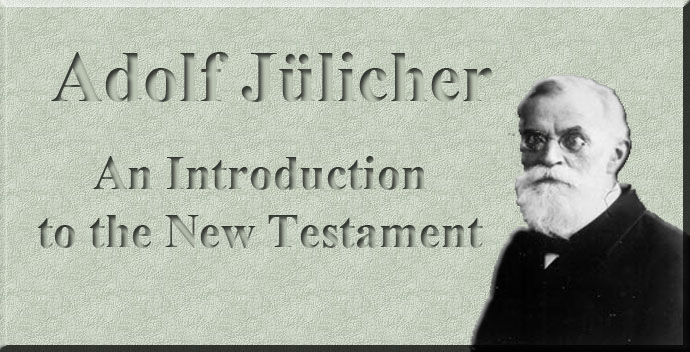
An Introduction to the New Testament
By Adolf Jülicher
PART TWO
Chapter 3 - Section 41
|
§ 41. The New Testament of the Syrian Church down to c. 350 Christians of Syrian speech have existed as long as the Church itself: but they usually understood one of the two dominant languages, and they accepted the Greek preaching without difficulty. But beyond the Euphrates, in Mesopotamia and Persia, this was not to be expected. For such Christian churches as were established there in the second century, Syriac was the language of the churches, and the language in which they must needs possess the Holy Scriptures. Edessa, the reigning house of which adopted the new religion soon after 200, was not long in becoming the centre of the young national church; and Bardesanes of Edessa, a man, it must be confessed, of Gnostic tendencies, created for it a literature of its own. He composed psalms and wrote dissertations in Syriac no less learned than edifying. For a century, it seems, he had no successors of note; their efforts did not go beyond translations from the Greek. It is not until we come to the East-Syrian Aphraates (about 340) and Ephraim of Edessa (f 373) that Syrian literature takes a new impulse, and the writings of these two men afford almost the only information we possess as to the compass of the oldest Syriac Canon. To the same period belongs the last redaction of the ʽDoctrina Addaei,ʼ which expressly enumerates the sacred books of the Christians. From this last it can be definitely shown that the ʽDiatessaronʼ of Tatian was for centuries the Gospel of the Syrians. Probably the separate Gospels were also translated fairly early into the vernacular tongue. Theologians were at any rate acquainted with them, and the text of the separate Gospels intrudes in innumerable instances into that of the ʽDiatessaron.ʼ Nevertheless the ʽDiatessaronʼ undoubtedly occupies the first rank until 350, and in the face of a custom so old and so deeply rooted, it may well be imagined that the Catholic demand that the four separate Gospels should be used as the Gospel of the whole Church was carried out with enormous difficulty.1 The Pauline Epistles and the Acts (ʽthe Acts of the Twelve,ʼ or even of ʽallʼ the Apostles) were placed beside the ʽEvangelium Christiʼ in the course, probably, of the third century. As late as 350 this literature shows no trace of the Catholic Epistles, still less of the Apocalypse. Since this very Apocalypse had been held in such high esteem in Rome ʽfrom time immemorial,ʼ Edessa cannot have drawn upon Roman sources for her original Canon, but, as might be expected, upon neighbouring Greek communities which had already rejected the Apocalypse and not yet admitted the Catholic Epistles. No Syrian distinguishes between the Epistle to the Hebrews and the other Epistles of Paul. This, in itself, is evidence for the dependence of Syria on the Hellenic East. That Philemon, which is never quoted by the earlier Syrians, was ever wanting in their Canon is improbable, for if this Epistle had been received as part and parcel of a large collection, it could not have been rejected again without strong reason. On the other hand, we learn for certain from the quotations of Aphraates and of Ephraim that the body of Paulʼs writings was more extensive in the Syrian Church than elsewhere. It contained a further correspondence between Paul and the Corinthian church (composed of scraps of other canonical material, wretchedly pieced together)—including, therefore, a third Epistle of Paul to the Corinthians, and the reply of the community. Apart from this, the ancient Syrians had a remarkable preference for Apocrypha. These they borrowed in great quantities from the Greeks—Gospels, Apocalypses, legends and teaching of the Apostles—using them for their edification with a piety not unlike that of Priscillian. But later on a general purging took place on the strictest lines: and to this the false Corinthian Epistles fell victims. Until a short time ago our only knowledge of these was drawn from the re-translation in the Armenian Bible, which did not reject them; but in 1891 Berger and Carriére were able to publish an original Latin text of them from a Milanese Bible-manuscript, containing more primitive characteristics than the Armenian. And now C. Schmidt and Harnack have made it certain that these inferior Epistles owe their origin to the Greek Acts of Paul, belonging to the second century. Thus the Syrian New Testament, about the year 350, is on a far lower plane of development than either the Greek or the Latin; it lacks all the Catholic Epistles, and the Syrians are unwilling to sacrifice the old ʽDiatessaronʼ for the four Gospels; with regard to the Epistle to the Hebrews and the Apocalypse, they agree with the majority of the Greeks, but they possess certain Apocryphal writings which the Greeks treated as of no account.
|
|
 |
 |
|
1) See above, p. 493.
|
|
-
Site Navigation
 Home
Home What's New
What's New Bible
Bible Photos
Photos Hiking
Hiking E-Books
E-Books Genealogy
Genealogy Profile
Free Plug-ins You May Need
Profile
Free Plug-ins You May Need
 Get
Java
Get
Java.png) Get Flash
Get Flash Get
7-Zip
Get
7-Zip Get Acrobat Reader
Get Acrobat Reader Get
TheWORD
Get
TheWORD